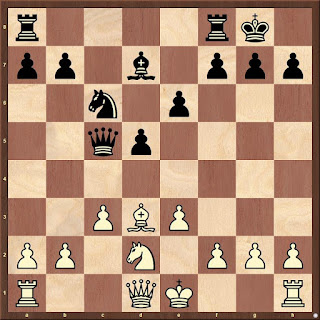BOOK REVIEW by Carl Portman
The London System in
12 Practical Lessons
by Oscar De Prado
Oscar De Prado
NEW IN CHESS
2021 - 1st edition (Soft cover, 272 pages)
https://www.newinchess.com/
What is this book about?
The
back cover wording states that:
The
London System is being played by an ever-increasing number of players, and it’s
easy to see why. Against virtually every Black defence after 1.d4 it offers
White an easy-to-learn and reliable set of lines. In the process, White has
interesting choices between strategic or more aggressive approaches, while
avoiding loads of opening theory. Ideal for players who don’t have much time to
study. Creative elite players such as Alexander Grischuk, Baadur Jobava,
Richard Rapport and even World Champion Magnus Carlsen have the London in their
repertoire.
Following
the enormous success of The Agile London System, the book he co-authored in
2016, Oscar de Prado revisits his favourite opening. The general focus is less
on theory and has a more practical approach – although he does present recently
played games and some important theoretical updates. De Prado avoids long and
complicated variations and concentrates on explaining straightforward plans,
clear-cut strategies and standard manoeuvres.
If
you follow De Prado’s lessons you are unlikely to face surprises or to emerge
from the opening in a worse position, and you will learn to make the right
middlegame choices. Studying this book is the most efficient way to acquaint
yourself with a flexible chess opening that is easy to learn and hard to
counter.
Contents
·
Explanation
of symbols
·
Preface
by GM Pepe Cuenca
·
Twelve
Chapters (called lessons)
·
Index
of Main Variations
·
Index
of names
·
Bibliography
My thoughts and comments
I
am not a London System player. I am though an exasperated Black player who
struggles to contain the system when White essays it. This book therefore is of
great interest to me in a chess world where the London system is so commonplace
at all levels. Some people make the mistake of thinking it is just a solid and
boring opening but beware – there really are lots of traps and if Black is not sufficiently
prepared, will find himself in the firing line.
The
twelve lessons range from general move orders and ideas, to lines with a speedy
h2-h4. There is of course a great deal more covered, including typical London
System endgames and the latest theoretical developments, which in this opening
is really necessary to learn.
Glenn
Flear (a reviewer who I rate extremely highly) said that the book ‘Will be the
reference work on the complete London System for years to come.’ That is high
praise indeed from a reviewer who is hard to impress. I started to flip through
the pages to obtain a feel for the contents, and then the diagrams and comments
sprang out at me and held my attention.
There’s
much to be interested in here. Even flicking through pages and looking at
diagrams I managed to build up a speedy picture of pawn structures and themes
such as opening files and diagonals.
Have
a look at this example. After:
1.
d4 Nf6 2. Bf4 e6 3. e3 c5 4. c3 Nc6 5. Nf3 d5 6. Nbd2 Bd6 7. Bg3 O-O 8. Bd3
Qe7
9. Ne5 Nd7 10. Nxd7 Bxd7 11. Bxd6 Qxd6 12. dxc5 Qxc5 *
The author writes ‘You might be surprised when we tell you plainly that Black is already lost now.’
What? I won’t reveal the whole story about why this assertion is made, but it
begins with the move 13.Bxh7+ and indeed that ‘Greek gift’ idea is a clear and
present danger.
Then there is this after 1.d4 d5. 2.Bf4 Nf6
3. Nc3 g6 4.e3 Bg7 5.h4
This is all rather aggressive stuff played
so frequently in modern chess. The book may well be written from White’s
perspective, but what is Black supposed to be doing against it? At least one can
study both sides of the argument here.
I do like the index of main variations at
the back. It is quick and easy to play through the first few moves of the
various lines and if they pique your interest then the relevant lesson number
is given, so you can locate it quickly.
Does the book achieve its aim?
It
is a very well written treatise on a popular opening. I cannot in all
conscience say I have compared it to any books written on the London System
before but look, if Glenn Flear thinks it is brilliant then I am happy based on
what I have seen to say the same. It is a complete repertoire and I am almost
tempted to try the opening as White myself. This is exactly the book for me if
I do so.
I
do want to say something for Black here. The developing main line against the
LS here has been…
Yes …b6 is definitely becoming a
favourite. Therefore, I assert that this book is not only for the White player
– but Black needs the information also. A very good Opening book indeed. Enjoy it,
but stop playing it against me please.
Who is the author?
Oscar De Prado Rodriguez (1973) is a FIDE
Master from Spain. He has successfully been playing the London System for many
years. In 2016 he published, together with co-author Alfonso Romero, the
acclaimed The Agile London System.







No comments:
Post a Comment